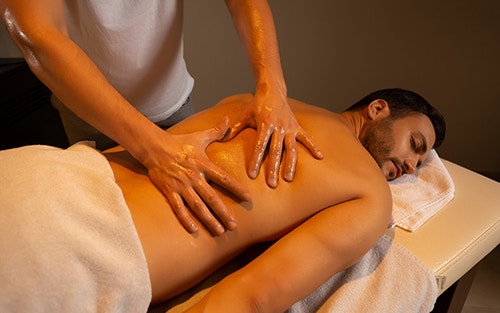Are you seeking relief from persistent muscle pain or want to enhance your physical well-being? Deep tissue massage targets the core of such issues, delving beyond surface-level tension to reach the deep layers of muscle and connective tissue. In this article, we’ll explore how this method provides more than just temporary relief; what differentiates it from other massages like Swedish and reveals its multifaceted benefits. Expect to learn about the techniques used, their therapeutic impact, and how to safely integrate deep tissue massage into your wellness routine.

Key Deep Tissue Massage Takeaways
- Deep tissue massage employs gradual, forceful strokes and consistent pressure to access and treat the body’s innermost layers of muscle and connective tissue.
- It helps alleviate chronic muscle tension, improve range of motion, and break down scar tissue.
- The benefits of deep tissue massage go beyond pain relief. They include improved blood circulation, lower blood pressure, and better mental health through increased production of serotonin and decreased cortisol levels.
- While generally beneficial, deep tissue massage can have risks, such as bruising or inflammation, and may not be suitable for everyone. This emphasizes the need for good communication with a qualified therapist and appropriate precautions based on individual health conditions.
Understanding Deep Tissue Massage Therapy
Deep tissue massage therapy is not your ordinary rub-down. It’s a focused and intentional manipulation of the body’s deeper layers of muscle and connective tissue. It uses slow, deep strokes and sustained pressure to unlock the chronic muscle tension hidden beneath the surface. It’s a dance of precision and strength, where the therapist becomes a sculptor, molding and easing the muscles back into a state of balance and fluidity. This form of massage therapy is like a whisper to the body’s most guarded areas of pain and tension, releasing knots and adhesions in underlying muscle and fascia that often elude more superficial treatments.

The craft of deep tissue massage techniques is both an art and a science, requiring therapists to wield tools like fingers, thumbs, and sometimes even elbows with meticulous care. Though sometimes intense, these movements aim to reach the deep areas of muscle where stress and injuries lurk, coaxing them into a state of release and healing. Focusing on trigger points, the therapist’s touch can significantly reduce muscle tension and pain, restoring movement and flexibility to the stiff and weary.
The Distinction of Deep Tissue from Swedish and Other Massages
While a Swedish massage might be likened to the gentle ebb and flow of a serene stream, deep tissue massage is the forceful current that carves through layers of rock to reshape the riverbed. The core of deep tissue massage therapy lies in its specific focus on relieving knots and tension in deeper muscle layers and fascia, distinguishing itself sharply from the lighter, more rhythmic strokes of Swedish massage. Here, the aim is not just to improve circulation but to break down the muscle adhesions and scar tissue that contribute to chronic muscle tension and impede natural movement.
Deep tissue massages are therapeutic, with each stroke and each press deliberately designed to penetrate the stubborn barriers of tight muscles and connective tissues. The benefits of deep tissue massage are manifold, including how deep tissue massage helped in:
- Providing pain relief
- Improving range of motion
- Breaking up scar tissue
- Reducing muscle tension and stiffness
- Promoting relaxation and stress relief
- Enhancing athletic performance
It’s a form of massage therapy that doesn’t just skim the surface but plunges into the very depths where the root causes of discomfort and restriction lie.
The Science Behind How Deep Tissue Massage Works
The efficacy of deep tissue massage isn’t just a subjective feeling of relief; there is a solid scientific foundation for how deep tissue massage works. The method involves a calculated application of firm pressure using fingers, thumbs, or elbows to dive into the deep layers of muscle and connective tissue. By specifically targeting muscle adhesions—those stubborn knots that restrict circulation, cause pain, and limit movement—deep tissue massage breaks them down to alleviate discomfort and restore mobility. This strategic breakdown is not an overnight miracle; it often requires multiple deep tissue sessions to safely and effectively treat deeper layers of tissue.

The physiological changes that occur during a deep tissue massage further support the healing process as the therapist’s hands work to unravel the tight spots, blood flow increases, reducing inflammation and encouraging the body to repair and recover at an accelerated pace. This surge of blood not only brings fresh nutrients to the affected areas but also whisks away the byproducts of muscle metabolism, facilitating a cleaner, healthier internal environment for tissues to thrive.
Pain Alleviation Through Deep Tissue Therapy
Pain is a complex sensation, often signaling that something in the body needs attention. Deep tissue massage steps in as a mediator, stimulating nerve fibers to interrupt pain signals to the brain and loosen clusters of tight tissue that are sources of discomfort. It’s a relief that can be profound, with the effects of deep tissue massage on chronic pain conditions like lower back pain and arthritis being comparable to the relief provided by over-the-counter medications such as ibuprofen. More than just temporary solace, deep tissue massage has shown to be a formidable opponent against chronic pain, even outperforming certain medications and medical interventions.
The beauty of deep tissue massage therapy lies in its adaptability. The intensity of the pressure applied can be adjusted to each individual’s comfort and pain threshold, making it a versatile option for those with sensitive conditions like fibromyalgia, whether battling the sharp stabs of a stiff neck or the dull throbs of low back pain, deep tissue massage offers a sanctuary of pain relief. It is a form of relaxation that does not shy away from the discomfort but instead gently and persistently works through it to provide a deeper sense of ease and well-being-.
Impact on Blood Pressure and Circulation
The human body is a vast network of highways, with blood vessels carrying precious cargo to every nook and cranny. Deep tissue massage acts as a traffic controller, ensuring smooth and improved circulation throughout this complex system. Just as it eases muscle tension, it also helps regulate blood flow, resulting in better overall health. Notably, deep tissue massage exerts a calming influence on blood pressure, with evidence showing a reduction in levels and a decrease in heart rate. This isn’t just a momentary dip; the reduction in stress and tension that comes from a deep tissue massage session can have lasting benefits for blood pressure.
The connection between the body and mind is further strengthened as deep tissue massage:
- Increases the production of serotonin, a key hormone that helps regulate blood pressure and heart rate
- Aids in maintaining a healthy blood pressure
- It brings a sense of happiness and calm
- Reinforces the holistic benefits of deep tissue massage therapy
- Harmonizes the body’s intricate systems
- Reveals the transformative power of touch on our overall well-being.
The Therapeutic Benefits of Deep Tissue Massage
Deep tissue massage has therapeutic benefits that go beyond just physical effects. It can also have a positive impact on mental and emotional well-being-. It’s an experience that touches the soul, with the lowering of cortisol levels and the rise of oxytocin levels providing a profound sense of stress relief and relaxation. This stress-busting effect is complemented by the massage’s ability to improve:
- lymphatic circulation and drainage
- breaking down scar tissue
- enhancing healing and flexibility
- easing muscle tension
- improving blood circulation
- improving posture
- increasing flexibility
- increasing serotonin levels
These positive changes create a ripple effect throughout the body, leading to an overall improvement in mood and well-being.

Moreover, deep tissue massage can be a guardian of health, offering the following benefits:
- Boosting the immune system by increasing white blood cell counts
- Contributing to overall wellness
- Providing immediate relief of tension
- Supporting long-term immune function
- Tapping into the body’s natural healing potential
The many benefits of deep tissue massage therapy make it a powerful ally in maintaining a healthy, balanced body and mind.
Addressing Chronic Pain and Sports Injuries
For those who live with the daily struggles of chronic pain, deep tissue massage is a beacon of hope. It expertly addresses pain, limited mobility, and areas prone to chronic tension, such as the neck, lower back, and shoulders. By stretching tight or twisted muscles and facilitating the removal of toxins, this form of massage therapy helps release muscle tension, serving as a cornerstone in the recovery process from injuries and muscle spasms. Athletes, in particular, find refuge in deep tissue massage, using it as a tool to treat and prevent sports injuries, delay muscle soreness, and enhance performance by addressing tense muscles.
Incorporating deep tissue massage into a physical therapy regimen can significantly enhance treatment outcomes. While an initial recommendation may be weekly treatments, the frequency can be adjusted as recovery progresses, tailoring the therapy to individual needs.
The targeted approach of deep tissue massage therapy provides:
- Immediate pain relief
- Improved flexibility and range of motion
- Increased blood flow and circulation
- Reduced muscle tension and stiffness
- Enhanced recovery and healing
This therapy lays the groundwork for a stronger, more resilient body capable of facing the demands of physical activity and daily life.
Enhancing Mental Wellbeing
The mind, too, reaps the rewards of deep tissue massage. In a world where stress and anxiety are all too common, this therapeutic massage stands as a pillar of mental health support. By lowering cortisol levels and boosting hormones like oxytocin and serotonin, deep-tissue massage offers a natural remedy for those battling the psychological pressures of life. Studies have shown that massage therapy, which includes deep tissue techniques, can not only enhance physical strength, such as grip strength, but also alleviate mental distress, reducing symptoms of anxiety and depression.
For those caught in the grip of insomnia, deep tissue massage may hold the key to a more restful night. Its ability to induce relaxation and ease mental turmoil serves as a complementary approach to other treatments, offering a holistic solution to improve sleep quality. With each session, deep tissue massage paves the way toward a more tranquil mind, demonstrating that the path to mental clarity and emotional balance often lies through the healing power of touch.
Potential Risks and Precautions of Deep Tissue Massage
While deep tissue massage offers many benefits, it’s essential to acknowledge that, like any therapy, it comes with potential risks and precautions. Sometimes, the intense pressure and vigorous strokes can lead to side effects such as bruising and inflammation. Specific individuals, particularly those with joint hypermobility, should approach deep tissue massage cautiously, as they may be more susceptible to injury. It’s also important to note that deep tissue massage is not recommended for areas with skin inflammation, infections, cardiovascular issues, acute phlebitis, deep venous thrombosis, recent traumatic injury, or an altered cognitive state.

Moreover, individuals with conditions that decrease sensation, such as diabetes, or those in the first trimester of pregnancy, should be especially cautious to prevent injury. Those on medication that affects bone structure or increases bleeding risk should also be vigilant. However, discomfort during a session can be mitigated by requesting less pressure or intensity, allowing for a less painful experience. A responsive therapist will adapt the intensity of the massage based on the client’s feedback, ensuring that the therapy remains within the bounds of safety and comfort.
Communicating with Your Massage Therapist
The importance of a strong therapeutic relationship cannot be overstated. Ensuring ease of communication and compatibility with your massage therapist can make a world of difference in the outcome of your sessions. Establishing a dialogue where you can openly share your needs, preferences, and any discomfort you might experience during the massage is essential. This kind of open communication allows the therapist to tailor the session to your specific needs and ensures that the pressure and techniques used are within your comfort zone.
Remember, a massage should be a restorative and relaxing experience, not a test of endurance.
Choosing the Right Massage Therapist for You
Selecting the right massage therapist is a crucial step in reaping the full benefits of deep tissue massage. It’s not just about finding someone with the right skills; it’s about finding a therapist who understands your unique body and health requirements. When researching potential therapists, consider their training, certification, and the reviews they’ve received from past clients. These factors can provide insight into their expertise and the quality of care they provide. Trusting your judgment after this research is also important; your intuition can often lead you to the best therapist for you.
Affordability is another key consideration. It’s wise to examine a therapist’s pricing structures and packages to ensure they align with your budget and frequency of sessions. This careful balancing act between quality and cost can help you sustain a regular massage routine without breaking the bank. After all, the goal is to make deep tissue massage a consistent part of your wellness journey, not a one-time indulgence.
Cost Expectations for Deep Tissue Massage Sessions
When budgeting for deep tissue massage, it’s helpful to clearly understand what you might expect to invest. Typically, a one-hour session costs between $70 and $150. However, this can vary based on several factors, including the location of the therapist’s practice and their level of expertise.
Some therapists may offer packages or membership rates that provide savings over time, making it more affordable to integrate massage into your health regimen. Always consider the value of the investment in relation to the potential health benefits when evaluating the cost.
Integrating Deep Tissue Massage Into Your Wellness Routine

Integrating deep tissue massage into your wellness routine is a personal journey that begins with identifying your goals, whether they be relaxation, pain relief, or improving your physical condition. Once you have a clear understanding of what you want to achieve, you can:
- Choose a massage therapist who aligns with your objectives
- Begin to experience the transformative effects of deep tissue therapy
- As your body adapts and your initial concerns are addressed, you can adjust the frequency of your sessions to suit your preferences, ranging from every five weeks to a couple of months.
While professional deep tissue massage is unmatched in its depth and precision, practical alternatives like massage guns can also offer some of the benefits of percussive therapy, providing a way to stimulate muscles and alleviate tension on your own. Furthermore, incorporating deep tissue massage post-physical activities can help delay the onset of muscle soreness and enhance athletic performance. By making deep tissue massage a regular part of your wellness routine, you give your body the attention and care it deserves, setting the stage for a healthier and more vibrant life.
Deep Tissue Massage Summary
As we reach the end of our exploration into deep tissue massage, it’s clear that this form of therapy is much more than a simple indulgence. It’s a scientifically backed approach to healing and wellness that reaches deep into the layers of our muscles and connective tissues. The targeted techniques of deep tissue massage therapy not only alleviate pain and improve mobility but also enhance blood circulation, lower blood pressure, and promote mental well-being-. The journey through the many benefits of deep tissue massage has shown us that it can be a powerful part of a holistic health strategy.
Incorporating deep tissue massage into our wellness routines requires thoughtful consideration, from choosing the right therapist to understanding the potential risks and the investment involved. Yet, the payoff is clear: a body more resilient to stress and injury, a calmer mind, more peace, and a general sense of well-being that permeates every aspect of life. As you consider integrating deep tissue massage into your life, remember that it is an investment in your most precious asset—your health.
Deep Tissue Frequently Asked Questions
Below are the more common deep tissue massage questions our yourfootpalace.com massage therapists are asked:
What is the difference between firm and deep tissue massage?
The difference between firm and deep tissue massage is that firm-pressure massage involves deep pressure but doesn’t have to target a specific muscle group. It can also be incorporated into other massage modalities.
What happens to your body after deep tissue massage?
After a deep tissue massage, you may feel a little tender in the worked area, but you shouldn’t experience active pain. Typical after-effects include sleepiness and feeling thirsty.
How often should I get a deep-tissue massage?
It’s best to start with weekly sessions for acute issues, then switch every five weeks to a few months for maintenance. Adjust based on individual needs and goals.
Can deep tissue massage help with chronic conditions like arthritis?
Yes, deep tissue massage has been shown to provide significant relief for chronic pain conditions such as arthritis, with effects comparable to over-the-counter pain medications.
Is deep tissue massage suitable for everyone?
Deep tissue massage is not suitable for everyone, especially those with skin inflammation, infections, cardiovascular issues, recent injuries, or certain medical conditions—approach with caution.
(706) 521-5290